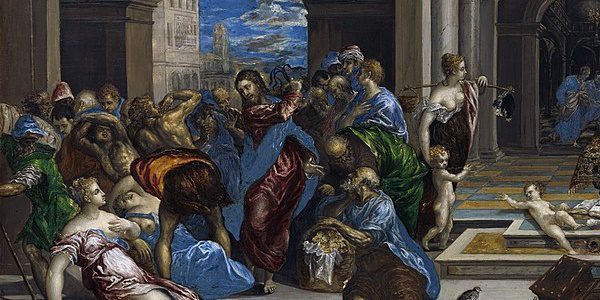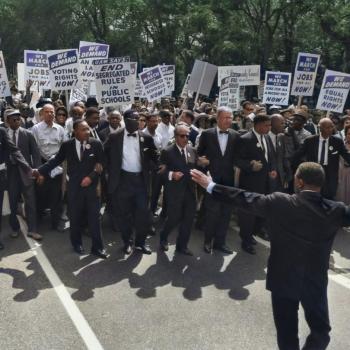Jesus is the new temple. Instead of allowing us to believe God is wrathful and in need of being paid off to placate his wrath (like being shaken down by the Mafia), Jesus undercuts the whole thing by showing us God is not only not wrathful but nonviolent, one who not only loves us when we behave but forgives us when we misbehave.
-Rev. Tom Truby
Pastors have a frequent question when they begin to discover mimetic theory. “That’s great. But how does it preach?”
Reverend Tom Truby shows that mimetic theory is a powerful tool that enables pastors to preach the Gospel in a way that is meaningful and refreshing to the modern world. Each week, Teaching Nonviolent Atonement will highlight his sermons as examples of preaching the Gospel through mimetic theory.
Lent3-2018-The Temple Becomes a Person
March 4, 2018
Thomas L. Truby
John 2:13-22
It is Lent three on our journey to Holy week and the gospel text has switched from St. Mark to the Gospel of John. In John’s gospel the cleansing of the temple occurs at the beginning of Jesus’ ministry rather than the end. In the other three gospels the ruckus at temple is the turning point where the temple authorities decide Jesus must be killed and it is very near the end of his ministry and close to the Crucifixion. He is threatening the Temple authority’s power by declaring them unnecessary. How is he doing this? He is saying God loves all people, has no wrath toward them and therefore does not need or want them to sacrifice animals, birds, their children nor any other creature to appease him. He didn’t need to be appeased. If this was true, if Jesus was right, or if the people began believing Jesus, the Temple would be unnecessary and its priests and administrators out of business.
The synoptic gospels present this message at the end of a sequence of historical revelations and it directly leads to Jesus’ crucifixion at the hands of the powers that be. As we said last week Jesus knows this is coming and prepares his disciples by telling them “he must be rejected by the elders, the chief priests, and the scribes, and be killed, and after three days rise again. He said all of this quite plainly.” He knew that when he attacked the temple, not because he was angry, but to dramatically symbolize its uselessness and end, they would react by destroying him. It was as predictable as night following day. What they didn’t know was that the non-violent and totally benevolent Face of God that Jesus was showing all people, would also apply to them. Even as they were killing him, Jesus declared his love toward them by forgiving them. This was the point of transformation and the revelation that caused the old, human-made temple that took forty-six years to build and still wasn’t done, to collapse from the inside.
It didn’t need violence to destroy it. It only needed the truth of nonviolence and forgiveness and it imploded from within.
Tony Bartlett, who I will tell you more about in a moment, writes: “What renders the Temple redundant is forgiveness: if we humans forgive, i.e. respond nonviolently, then necessarily there will be no need for Temple and we will be one with the forgiveness/nonviolence of the Father. Forgiveness deconstructs and replaces sacrifice.”
John is different from the other three gospels. He is more theological and so starts his story with “In the beginning was the Word, and the Word was with God, and the Word was God,”—the big picture. In John’s writing the actions of Jesus’ life in relation to the Temple are so important to Jesus’ message that he starts his story with the overturning of the money changer’s tables. But it couldn’t have happened this way historically because the Temple leaders would have wiped Jesus out before he had a chance to begin to spread his news of a non-violent God if he had started his ministry there. So here we have a historical contradiction in the Bible that actually underlines the importance of the ruckus in the temple all four of the gospel writers were trying to convey.
I want now to make an aside. Just before I got sick last December I received a book by Anthony Bartlett entitled Seven Stories: How to Study and Teach the Nonviolent Bible. Tony was one of two teachers that introduced me to Girardian Theory with its emphasis on a nonviolent God and forgiveness in 2002 in Upstate New York.
I read his book eagerly, though I had difficulty comprehending what he was saying. I now wonder if the brain condition that led to my hospitalization was already affecting my thinking. After leaving the hospital I had totally forgotten that I had ever read this book in the first place. When my friend Roy insisted I had I would not believe him until he showed me the notes I had written in the margin in my own hand.
The sixth story of the seven that Tony says shaped how human’s think was entitled “The Temple and its Deconstruction.” Our lectionary passage from John traces the way Jesus announced the deconstruction, the taking apart of the Temple, and all other sacrificial institutions. “Temple” is a worldwide human institution that produces the “holy” through killing/sacrifice. I want to use Tony’s words to try to explain what Jesus was doing when he disrupted the temple.
John’s description highlights both the expulsion of the animals and the money changers. What is going on? In both cases Jesus is bringing the actual operation of the Temple to a halt. Jesus is not simply “clearing the Temple, or “cleansing “it, he is rendering sacrifice impossible. If there are no animals, there are no sacrifices. If there is no money to buy the animals, again no sacrifice.
Do you see how far this is from an angry Jesus losing his temper? This is something way, way bigger than that. From the beginning we have made God in our own image and made him angry because we have been angry. We were rivalrous and jealous toward each other and projected that onto God. Since we feel that way toward others surely God feels that way for us. Since we have seen God as wrathful and envious of us, we have attempted to appease God so that God will be good to us and let us live. The Temple is the institution that carries out this transaction. People used their scarce and hard-earned money to buy cattle, sheep and doves that would then be slaughtered and burned on the altar so that the one who bought these creatures would be safe from misfortune or disease caused by an angry God who hadn’t been paid off. But if God is not angry, and maybe even forgiving, this is not necessary.
Jesus plugs up the machinery of sacrifice. He doesn’t cleanse it as though once cleansed it can be used again. He is not clearing the Temple as though the problem had been its overcrowding with commercial interests and animal dung. He is telling the world the Temple has seen its day and Jesus is its replacement.
“The Jews then said to him, ‘What sign can you show us for doing this?’ Jesus answered them, ‘Destroy this temple, and in three days I will raise it up.’
The Jews then said, ‘This temple has been under construction for forty-six years, and will you raise it up in three days’ But he was speaking of the temple of his body.”
Jesus is the new temple. Instead of allowing us to believe God is wrathful and in need of being paid off to placate his wrath (like being shaken down by the Mafia), Jesus undercuts the whole thing by showing us God is not only not wrathful but nonviolent, one who not only loves us when we behave but forgives us when we misbehave. The forgiving body of Jesus whom God raised up in three days is the new temple. With Jesus being raised in three days, relationship is restored all around and none are lost. The human and the divine are on the same page and there is no gap between them that needs to be appeased. As Tony says, “forgiveness deconstructs and replaces sacrifice.” This new temple is not separate from the world but fills it completely. No one is excluded. There is no inner and outer chamber. Jesus as Temple is for all people. This temple doesn’t take life, it gives it. In a moment we will take Communion together where, as Tony says:
Jesus replaces the ritual of the sacrifice with this symbol of his life and death. He replaces the sacrificed animal with bread and wine, as a constantly-to-be-enacted parable of his non-violent self-giving death. Nothing is hidden here. (Seven Stories, 190.).
The Eucharist displaces sacrifice and shows Jesus as the New Temple. No sacrifice of humans or animals, no outraged blood to rile us up and move us toward violence—only the self-giving sacrifice of the Son of God represented as bread and wine. As Tony says, “What is disclosed is pure and simple nonviolence and forgiveness.” Thanks be to God. Amen.
Image: Christ Driving the Money Changers from the Temple, El Greco, Wikimedia, Public Domain.
Stay in the loop! Like Teaching Nonviolent Atonement on Facebook!












